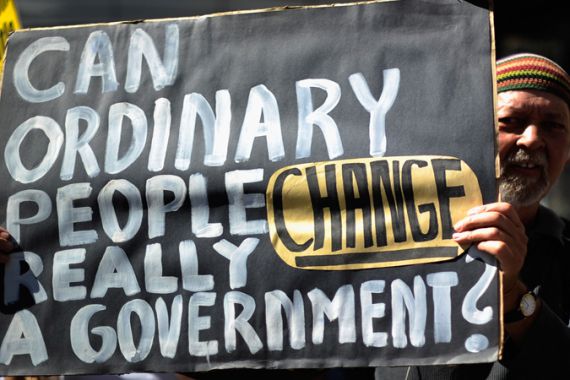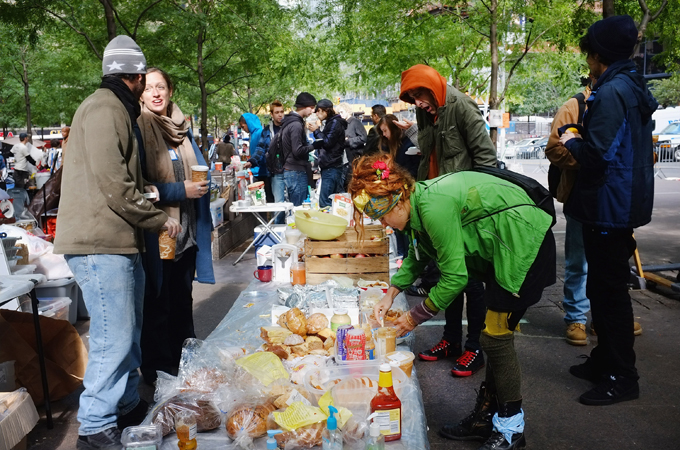Occupy Wall Street to a global intifada?
A ‘shaking off’ of Wall Street seems a more appropriate term than ‘occupying’ – since it is not violent or forceful.

 |
| The protesters of Occupy Wall Street have carried out their act of civil disobedience without anarchy or violence [GALLO/GETTY] |
On Wednesday, October 5, I joined thousands of others and marched down lower Manhattan to ‘occupy Wall Street’. Seeing thousands of people marching peacefully together under the banner of occupying struck me in profound and contradictory ways.
The marches and occupation were orderly and disciplined. There was neither a mob mentality, nor a sense of anarchy, nor any violence. No one crushed anyone else, in fact people apologised if they so much as tread over each other’s toes. No one smashed windows of the countless Starbucks coffee shops, coporation buildings or banks on the route.
Everyone obeyed the flow determined by the New York Police Department (NYPD): Walking on sidewalks behind barricades, congregating in open spaces of parks, and for the most part not standing on streetlights, signs or scaffolding to get a bird’s eye view.
|
“Targeted at Wall Street, at corporate America, at rising unemployment, at taxation inequalities …“ |
The feeling was certainly one of dispossession – targeted at Wall Street, at corporate America, at rising unemployment, at taxation inequalities, at rising student loans, at seemingly out-of-control military spending. However, the feeling was also one – on the sidewalks, parks, and squares- of friendliness and solidarity.
The ‘occupation’ of Zuccotti Park (a few blocks north of Wall Street and where the occupation began a few weeks ago) was one of non-violence, harmony and festivity. Amid the food line, sleeping bags and sprawled out bodies on the ground, conversations were taking place, some in the glow of an open laptop.
Between the plastic bags stuffed with clothes and medical supplies, spaces were devoted to poster-making, where anyone could pick up or return a ready-made sign or paint his or her own. Brushes, rainbows of paints, markers, and cardboards were layed out on the ground, inviting sparks of semantic or visual imagination.
An impromptu performance evoking an outdoor techno-rave gathered a swaying, clapping crowd. Much of this was occurring under the watchful eye of a strange piece of NYPD machinery that can only be described as half-crane/half one-way-mirror lookout post.
What kind of occupation?
The meaning of ‘occupy Wall Street’ is an occupation by the people of the material and symbolic centre of corporate power, of the exploitative form of capitalism that the 99 per cent are victims of.
The phrase connotes a certain beauty, naivete, and democratic ideal: To live in, to fill, to engage with, to work over the space that should belong to the people. To occupy is meant to reclaim the street as a project of spatial justice, but also, and more poignantly, as an economic, political, and symbolic project.
‘Occupation’ seems to be a conscious play on words highlighting the right to assemble in a neutral sense: To be present in a place.
But occupation is also the right to use urban spaces for the creation of a grassroots polity to voice opposition to the powers at hand and evokes resistance. To occupy here co-opts the master’s own tools.
In drawing on Tahrir Square especially, as the Occupy Wall Stree (OWS) website suggests, this occupation is seizing power on behalf of the many, in an attempt to circulate flows out of Wall Street back onto Main Street. It further plays on the meaning of occupation as a synonym for a job, as one poster declared “I lost my job but found an occupation.”
|
“I lost my job but found an occupation.“ – Poster at Occupy Wall street |
As an Arab, I felt a sense of honour spotting Egyptian flags and posters with reference to the Arab Spring, delighted to see that the proverbial ‘Arab street’ had been lifted from its position of backwardness and unruly, scary fanatics. It was being coopted, in the form of Tahrir Square, to mean a democratic, non-violent movement.
But as a Palestinian, I could not think of myself as ‘occupying’.
Defining occupation
Occupation is a privileged and problematic political term to claim: Only those in relative power can siege, capture, or take over, and they usually do so by force. No Palestinian would ever think of expressing opposition and resistance by ‘occupying’ places of Israeli power, be they checkpoints, settlements, or walls of different kinds than those on Wall Street, just as no one in Cairo claimed that they were ‘occupying’ Tahrir Square.
The orderliness on the streets of Manhattan as an occupation struck me as a disjuncture. This was certainly not the type of occupation I have experienced it on the streets of Ramallah, Gaza, or Nablus!
I tend to think of ‘occupation’ as more or less referring to one thing: Israeli occupation. To occupy is a violent, exploitative affair. It is a spatial, political and economic manifestation of power imbalances. In its Israeli form, occupation is an expression of military power, of colonial settlement, of seizing land and streets by force.
Masked as it has become under supposed, a stalled ‘peace process’, occupation today is about the bureaucratic, administrative, and hi-tech means of attempting to keep a people subjugated while continuing their territorial dispossession. In short, occupation, for many Palestinians, has meant a way to justify turning them homeless or stateless by all kinds of discursive and material means.
It was that NYPD crane-lookout post that was a tool of the mechanics of occupation, reminiscent of Israeli checkpoints and sniper towers. What the people were doing on the streets was not occupation, but its opposite: Resistance.
The first intifada – whose images of young boys throwing rocks at over-powering Israeli military tanks are etched in near-global collective memories – was one of the widest modern-day popular uprisings in the Middle East. For many in Tahrir and other hotspots of the Arab Spring, mass mobilisation on the streets was something they had regionally attributed to Palestinians.
Civil disobedience
 |
| The occupation at Wall Street might be better described as resistance [GALLO/GETTY] |
More importantly here, is that the intifada was marked and expressed across almost the entirety of the Palestinian population in the Occupied Territories in various forms of civil disobedience: Mass strikes, boycotts of Israeli products, refusal to work in Israeli establishments, refusal to carry mandatory Israeli-issued ID cards, holding back the payment of taxes, hoisting up Palestinian flags, spraying walls and outdoor surfaces with graffiti.
As a t-shirt worn by a demonstrator at Occupy Wall Street read: “Warning: Civil disobedience results in increased human rights.”
The violence waged at the time of the first intifada was predominantly in the form of the state-sanctioned Israeli military violence against Palestinian civilians who were standing up for their rights. It was the regime of occupation that was violent, not those rising up against it.
|
“What the people were doing in the streets was not occupation, but its opposite: Resistance.“ |
There is violence surrounding Occupy Wall Street, but it is of a different nature. This kind of violence is at once more abstract and ubiquitious, off-shored but omnipresent: The violence manifested by the vagaries of the economic system in place, of the results of the preferential treatment to corporations and the wealthy elite rather than the worker bees – the students, the unions, the youth, and the rest of the 99 per cent.
Such violence is of course related to military and kinetic violence, as noted on numerous signs in Foley Square and Zuccotti Park demanding an end to military wars and channeling those billions of dollars into education and healthcare instead. And one need to also note that the violence present in the form of a with-held violence, the threat of it can descend anytime, as was palpable in over-whelming police presence.
The Israeli military occupation regime, prior to the intifada, was also one that prohibited political gatherings in public spaces, certain kinds of cultural productions, displays of nationalism such as the waving of flags, and political expressions such as graffiti.
Yet between Washington Square (where part of the march began) and Wall Street, there were ample posters, signs, and American flags in the form of bandanas, scarves, and the red-white-and-blue of the various pins and posters. Peaceful protestors as occupiers and violence as the one veiled behind the concrete, stone, and glass walls of the banks, was a mirror opposited of what I have known as a Palestinian.
It might be more appropriate to think of those sprawled out “all day! all week!” on Wall Street as campers, in the French sense of literally making a scene. To camp is to present oneself in an expansive but flimsy manner, with overtones of theatricality and provocation. To camp creates the conditions for the drama to unfold.
By drawing on the images of exposure and shelter, camping signals to the bankers and politicians the impermanence of their systems, for all dwellings can only be temporary.
But if we are to find a commonality between Wall Street and Tahrir Square and connect them to Pearl Square, Puerta Del Sol and countless others, a return to the meaning and practice of the first intifada might be in order.
The demonstrations, sit-ins, and camp-outs across the globe are people’s demand for their liberation from various forces of political and economic tyranny. The are inter-related to unemployment, crises of capitalism, dictatorial regimes, individual and national debt burdens, expensive military campaigns, and sky-rocketing housing prices.
Intifada, while usually translated as uprising or resistance, literally means ‘shaking off’. From Wall Street to Syntagma Square, from Rothschild Boulevard to Sana’a Tahrir Square, it is a global intifada that is afoot: People are rising up to shake those in power off their backs.
As another demonstrator’s t-shirt in Manhattan read: “We Are All Palestinians”.
Helga Tawil-Souri is an Assistant Professor of Media, Culture, and Communication at New York University. Her book Digital Occupation is forthcoming.
The views expressed in this article are the author’s own and do not necessarily reflect Al Jazeera’s editorial policy.
